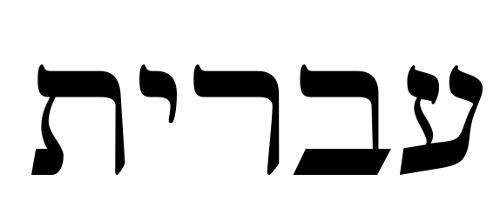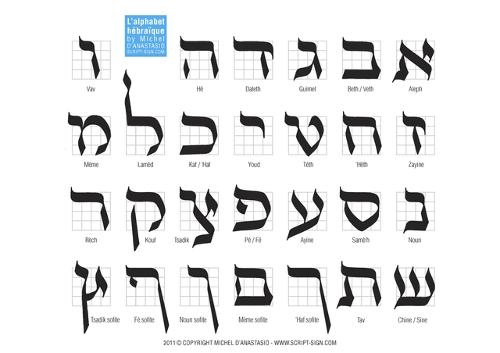ISRAEL
Language

Language
Cities in ISRAEL
| Eilat | Jerusalem |
Language
 Hebrew written in HebrewPhoto: Tenth Plague CC 4.0 International no changes made
Hebrew written in HebrewPhoto: Tenth Plague CC 4.0 International no changes made
There are two official languages in Israel: (modern) Hebrew and Arabic. Modern Hebrew, also called Ivrit, is spoken by almost the entire Jewish population.A number of groups of immigrants have also retained their language of origin.
The main languages are briefly described below:
Biblical Hebrew
Biblical Hebrew was from the 2nd century AD. a dead language until the end of the 19th century. The Old Testament, based on the Jewish Tanakh, the part of the Bible that dates from before the beginning of our era, was originally drawn up almost entirely in Hebrew.
In Hebrew we can distinguish:
1. Classical Hebrew (of which Biblical Hebrew is the bulk)
2. Post-Biblical Hebrew (from the Talmud and the so-called "midrashim", texts that explain the biblical texts)
3. Medieval Hebrew (that was when people first started writing about non-religious matters and because of that all kinds of new words had to be added.
4. Modern Hebrew
 Hebrew alphabetPhoto: Maltin75 CC 3.0 Unported no changes made
Hebrew alphabetPhoto: Maltin75 CC 3.0 Unported no changes made
Modern Hebrew
The revival of Hebrew as a living language is due to the Lithuanian Jew Eliezer ben-Yehuda, who settled in Jerusalem in 1881. He distributed glossaries for modern society among the new generation of Hebrew speakers. From the introduction of the British Mandate, Hebrew was an official language alongside English and Arabic. New emigrants were required to take a course in modern Hebrew or Ivrit, and this language is now spoken by some five million people in Israel. A Hebrew university was opened as early as 1924, and in 1966 Hebrew author Shmuel Yosef Agnon won the Nobel Prize in literature. Hebrew is a Semitic language which, like Arabic, is written from right to left. It is difficult to convert into Latin letters because it has no upper and lower case letters, for example. In fact, Hebrew has two alphabets, one for printed and one for handwritten text. The Hebrew script has 22 consonants and the missing vowels have been replaced by sound marks. Each letter also represents a number, but numbers are often written as the numbers known to us.
Arabic
After Muhammad's death, Palestine was one of the first areas to be conquered by the Muslims and rapidly becoming Islamized. In addition to Arabic as a spoken language, there is also a liturgical language, classical Arabic, which, however, is increasingly distinguishing itself from Arabic spoken language. There are various Arabic dialects in Israel, which were brought by Jews from North Africa and the Middle East. The Arabic is written from right to left, except for numbers, which are written from left to right. Just like in Hebrew, vowels are replaced by sound signs
Palestinian Arabic
The Palestinian Arabic dialect is spoken by Palestine-born Arabs and by Jews who settled in the Holy Land before 1948.
This dialect is very similar to the Syrian and Lebanese dialect, but it has also been influenced by Hebrew and English. There are also regional differences and the language sounds different in cities and in the countryside.
English, French, Russian, Spanish, Yiddish
In Israel many other languages are spoken by immigrants who grew up in a different culture. For example, the so-called Jekkés, German immigrants from the 1930s, still only speak German. Other languages still spoken include Amharic, Ethiopian, Dutch, Hungarian, Polish, Chinese, and even Ladin, which is still spoken by descendants of Jews who were expelled from Spain in 1492.
English was the official language during the British Mandate and is still very important today. For pupils, English is compulsory at school from the age of 10.
In response to English colonialism, French was the third official language until the Six Day War in 1967, but is increasingly being supplanted by English. Many North African emigrants in particular still speak French.
The number of people who still speak Russian has grown enormously after the massive immigration from the Soviet Union and Russia. They live a lot in new cities like Carmiel, Natzrat Ilit and Arad.
Spanish is still mainly spoken by South American immigrants, who often settled in kibbutzim, but now also live in cities such as Carmiel, Ashkelon and Tel Aviv.
Yiddish originated in medieval Central Europe and is a mixture of Hebrew, German and a number of Slavic languages. After the extermination of the Jews in Eastern Europe, Yiddish seemed to be disappearing, but it is still spoken by a number of immigrants and in ultra-Orthodox communities in Russia, Poland, the Baltic States and Romania. Yiddish language and literature are even still taught in universities.
A few words:
| English | Hebrew | Arabic |
| good morning | boker tov | sabah al cheir |
| good night | lajla tov | tisbah ala cheir |
| please | bevàkasha | min fadlak |
| beer | bira | bira |
| food | ochel | akl |
| thea | te | shay |
| wine | jajin | nabid |
| sugar | sukar | sukkar |
Sources
Cahill, M.J. / Israel
Chelsea House Publishers
Gerhard, C. / Israël
Van Reemst
Griver, S. / Israël : inclusief de Palestijnse Autonome Gebieden
Kosmos-Z&K
Groeneveld, M. / Israël: een leesboek
Boekencentrum
Het Heilig Land
Standaard
Rauch, M. / Israël
ANWB
Sanger, A. / Israël
Van Reemst
Semsek, H.-G. / Israël : Westelijke-Jordaanoever, excursies naar Jordanië
Het Spectrum
CIA - World Factbook
BBC - Country Profiles
Copyright: Team The World of Info